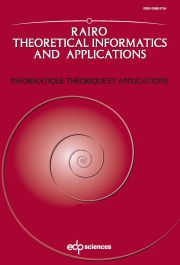Article contents
Strategies to scan pictures with automata based on Wang tiles
Published online by Cambridge University Press: 15 March 2011
Abstract
Wang automata are devices for picture language recognition recently introduced by us, which characterize the class REC of recognizable picture languages. Thus, Wang automata are equivalent to tiling systems or online tessellation acceptors, and are based like Wang systems on labeled Wang tiles. The present work focus on scanning strategies, to prove that the ones Wang automata are based on are those following four kinds of movements: boustrophedonic, “L-like”, “U-like”, and spirals.
- Type
- Research Article
- Information
- RAIRO - Theoretical Informatics and Applications , Volume 45 , Issue 1: ICTCS 09 , January 2011 , pp. 163 - 180
- Copyright
- © EDP Sciences, 2011
References
- 6
- Cited by


